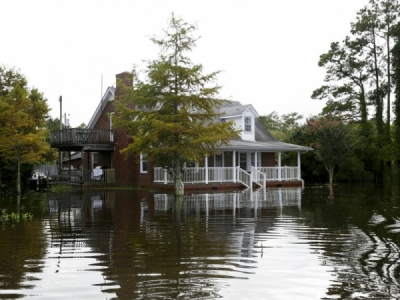
Posted on June 25, 2019
Putting up walls to protect the seven cities from rising sea levels would cost the region more than $4.6 billion, according to a nationwide study released Thursday.
The Center for Climate Integrity, a project of the nonprofit Institute for Governance and Sustainable Development, released estimates of how much it would cost to build seawalls in coastal communities in 22 states and the District of Columbia.
Virginia is near the top of the list, ranked the fourth most expensive with seawalls costing more than $31 billion.
The study focuses on what it would cost to put up the barriers and does not include other mitigation measures likely necessary to guard against rising waters.
But the concept of seawalls is just a proxy, said Skip Stiles, executive director of Wetlands Watch in Norfolk. Researchers used data to calculate what it would take to protect public infrastructure, and applied the universal idea of a seawall as one way to get a cost estimate.
The center worked with a climate adaptation-focused engineering firm and mapping specialists at the University of Colorado to estimate the costs of protecting infrastructure, according to its website. Researchers used a “sophisticated sea level rise model,” one-year storm surge estimates — the level coastal water rises in any given year during a typical storm — and shoreline data from the National Oceanic and Atmospheric Administration.
Because it excludes spots like federal land, private infrastructure and military bases, the estimates are also “extreme lowballs,” Stiles said.
Virginia Beach alone would need more than $1.7 billion for the barriers, according to the study, making it the third most costly city out of 1,902 studied.
Seawall projects in the other Hampton Roads cities also come with hefty price tags:
- Chesapeake: $675 million
- Hampton: $642 million
- Norfolk: $574 million
- Suffolk: $484 million
- Newport News: $418 million
- Portsmouth: $176 million
“The cost is real, and it’s big,” Stiles said. “It’s the equivalent of a Category 1 hurricane coming our way slowly. We have time to prepare, but it’s not going to go away.”
The first thing Hampton Roads should do, he said, is list out all of the “critical projects we need and how they fit with each other,” then prioritize. And it needs to happen regionally — not the “piecemeal approach” happening now.
Regional planners recommend local officials factor in at least 1.5 feet of sea level rise above average high water levels through 2050, 3 feet through 2080 and nearly 5 feet after that. Meanwhile, the land itself is sinking.
Virginia Beach City Manager Dave Hansen has said the city is “at war” with sea level rise, calling it “public enemy No. 1.”
City officials drafted plans to combat flooding that include constructing or extending seawalls at the Boardwalk and in Back Bay. The plans, which could cost up to $3 billion and protect up to 45,000 homes, also include things like high-tech flood gates and levee systems, the Pilot has reported.
Langley Air Force Base built a shoreline seawall and door dams. Norfolk officials originally planned to use a series of seawalls and pumps to drain the flood-plagued Chesterfield Heights neighborhood, using $112 million of federal money.
Instead, the Pilot reported, the city’s using the area to test an array of “softer options” like earth berms.
“We don’t want to wall in this whole city,” Christine Morris, Norfolk’s chief resilience officer, said earlier this year.
Stiles said there’s a seawall around Nauticus in downtown Norfolk, but it’s decades old and needs to be raised.
Norfolk has also proposed storm-surge barriers, which allow water to flow freely but are closed during storms.
Just this week, the City Council voted to allow Norfolk neighborhoods raise their own taxes to fund flooding fixes.
Stiles said the takeaway from this week’s study is not the exact sticker price of seawalls; it’s the increasingly clear message that Virginia needs to raise tens of billions of dollars to protect its communities, and fast.
“This is not meant to be a blueprint for action,” Stiles said. “It’s meant to be a wake-up call.”
Katherine Hafner, 757-222-5208, katherine.hafner@pilotonline.com, @khafner15
Source: coastalnewstoday.com





